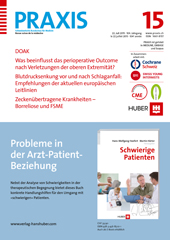Blutdrucksenkung vor und nach Schlaganfall: Empfehlungen der aktuellen europäischen Leitlinien
Abstract
Zusammenfassung. Die arterielle Hypertonie ist der wichtigste modifizierbare Risikofaktor für das Erleiden eines Schlaganfalls. Bis zu 50% aller Schlaganfälle weltweit könnten auf einer unzureichenden Blutdruckeinstellung beruhen, wobei das Risiko ab Blutdruckwerten über 115/75 mmHg sowohl im systolischen als auch im diastolischen Bereich kontinuierlich zunimmt. Patienten mit pathologischem zirkadianem Blutdruckverlauf scheinen ebenfalls ein erhöhtes Schlaganfallrisiko zu haben. Der Nutzen einer antihypertensiven Therapie sowohl zur Primär- als auch Sekundärprävention des Hirninfarktes ist unbestritten. Allgemein sind Zielwerte unter 140/90 mmHg anzustreben. Die Blutdrucksenkung an sich scheint hierbei wichtiger zu sein als die Klassenzugehörigkeit der verwendeten Antihypertensiva. Im Akutstadium des ischämischen Schlaganfalls sollte der Blutdruck – ausser in Sonderfällen wie geplanter Lysetherapie – nur bei Werten über 220/120 mmHg vorsichtig gesenkt werden.
Abstract. Arterial hypertension is the most important modifiable risk factor for stroke. Up to 50% of all strokes may be attributable to hypertension. The risk of stroke is known to increase in a continuous fashion with a blood pressure (BP) of 115/75 mmHg and higher. Patients with an abnormal circadian BP behavior also appear to be at risk. The benefit of antihypertensive drug therapy has been shown in both primary and secondary prevention of stroke. Generally, a BP target of under 140/90 mmHg is recommended. BP lowering itself appears to be decisive rather than choice of the antihypertensive drug. In the acute phase of ischemic stroke and with some exceptions, BP should only be actively lowered at values over 220/120 mmHg.
Résumé. L’hypertension artérielle est le risque modifiable le plus important lié à l’apparition d’un accident vasculaire cérébral. 50% des accidents vasculaires cérébraux survenant au niveau mondial seraient dus à un ajustement insuffisant de la tension artérielle, le risque augmentant à partir de valeurs artérielles supérieures à 115/75 mmHg, autant pour la tension systolique que diastolique. Les patients ayant une courbe de tension circadienne pathologique présentent eux aussi un risque plus élevé de subir une attaque cérébrale. Les bénéfices du traitement de l’hypertension sur les accidents vasculaires cérébraux sont incontestables autant dans le cadre de la prévention primaire que secondaire. En général, il s’agit d’atteindre des valeurs en dessous de 140/90 mmHg. Une diminution de la pression artérielle en soi est plus importante que le choix de la classe thérapeutique de l’antihypertenseur. A l’exception de quelques situations particulières comme lors d’une thrombolyse prévue à l’avance, la pression artérielle ne devrait être abaissée qu’avec précaution en dessous de 220/120 mmHg dans la phase aiguë de l’accident vasculaire cérébrale ischémique.



